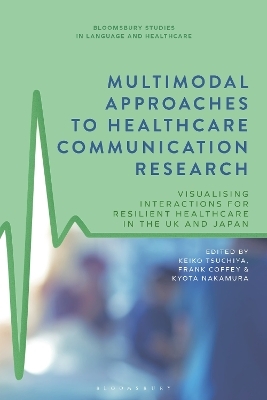
Multimodal Approaches to Healthcare Communication Research
Bloomsbury Academic (Verlag)
978-1-350-29847-7 (ISBN)
Providing an interdisciplinary examination of the theories and rationales of resilient healthcare, the book engages with a range of case studies from a variety of healthcare settings in the UK and Japan and considers the application of advanced technologies for visualising healthcare interactions and implementing virtual healthcare simulation. In doing so, it showcases a number of multimodal approaches and highlights the potential benefits of multimodal and multidisciplinary approaches to healthcare communication research for enhancing resilience in their local contexts.
Keiko Tsuchiya is Associate Professor at the Graduate School of Urban Social and Cultural Studies, Yokohama City University, Japan. Frank Coffey is Honorary Professor at Nottingham Trent University and Director of DREEAM (Department of Research and Education in Emergency Medicine Acute Medicine and Major Trauma) at Nottingham University Hospitals’ NHS Trust, UK. Kyota Nakamura is Professor at the Department of Quality and Safety in Healthcare, Yokohama City University Medical Centre, and at the Department of Clinical Quality Management, Osaka University Hospital, Japan.
Foreword, Kazue Nakajima (Osaka University Hospital, Japan)
Introduction, Keiko Tsuchiya (Yokohama City University, Japan)
Part I: Multimodal Practice for Resilient Healthcare
Case Studies in Japan
1. Resilient Performance of a Medical Team in the Critical Care Setting, Kyota Nakamura (Osaka University Hospital, Japan)
2. Novel Approaches to Identify Preventive Factors Against Falls Among Hospital Inpatients, Takeru Abe (Yokohama City University Medical Centre, Japan) and Kyota Nakamura (Osaka University Hospital, Japan)
3. Creating Interactional Spaces for Making Requests, Kyota Nakamura (Osaka University Hospital, Japan), Takuma Sakai (Matsuoka Emergency Medical Service, Japan), and Keiko Tsuchiya, (Yokohama City University, Japan)
Case Studies in the UK
4. A Multimodal Linguistic Analysis of Gaze and Active-Listenership in Emergency Department Team Interactions, Sarah Atkins (Aston University, UK) and Malgorzata Chalupnik (University of Nottingham, UK)
5. Projectability and Coordinated Actions in Emergency Care, Keiko Tsuchiya (Yokohama City University, Japan), Frank Coffey (Nottingham University Hospital NHS Trust, UK), and Alison Whitfield (Nottingham University Hospital NHS Trust, UK)
Part II: Different Approaches to Healthcare Communication and Culture
6. Understanding the Impact of Restricted Interests on the Social Interactions of Adults with Autism Spectrum Disorder, Kyoko Aizaki (Lancaster University, UK), Chris Walton (Lancaster University, UK), and Charlie Lewis (Lancaster University, UK)
7. Beyond Lingua-cultural Barriers: Co-construction of Professional Competence by Japanese and International Care Workers, Junko Mori (University of Wisconsin-Madison, USA) and Chiharu Shima, (Akita International University, Japan)
8. Silent Replies as Indicators of Shared Common Ground between a Leader and Members in an Emergency Care Team, Akira Taneichi (Yokohama City University, Japan)
9. Different Frames in Emergency Care Interactions between the UK and Japan, Keiko Tsuchiya (Yokohama City University, Japan), Akira Taneichi (Yokohama City University, Japan), Frank Coffey (Nottingham University Hospital NHS Trust, UK), and Kyota Nakamura (Osaka University Hospital, Japan)
Part III: Visual and Virtual Technologies for Healthcare Simulation
10. The Creation and Validation of a 360-degree Video-Based Situation Awareness Training and Assessment Tool for Trauma Team Leaders, Andrew Mackenzie (Nottingham Trent University, UK), Mike Vernon (Nottingham Trent University, UK), James A. C. Myers (Nottingham Trent University, UK), and Rob Hutton (Nottingham Trent University, UK)
11. Using Immersive Virtual Environment for Educational Purposes, Miharu Fuyuno (Kyushu University, Japan)
12. Capturing a Trauma Leader's Eye Gaze: a Semi-automatic Gaze-recognition Program, Takeshi Saitoh (Kyushu Institute of Technology, Japan), Keiko Tsuchiya (Yokohama City University, Japan)
Conclusion, Keiko Tsuchiya (Yokohama City University, Japan), Frank Coffey (Nottingham University Hospital NHS Trust, UK), and Kyota Nakamura (Osaka University Hospital, Japan)
References
Index
| Erscheinungsdatum | 08.03.2023 |
|---|---|
| Reihe/Serie | Bloomsbury Studies in Language and Healthcare |
| Zusatzinfo | 51 bw illus. |
| Verlagsort | London |
| Sprache | englisch |
| Maße | 156 x 234 mm |
| Themenwelt | Geisteswissenschaften ► Sprach- / Literaturwissenschaft ► Sprachwissenschaft |
| Studium ► Querschnittsbereiche ► Prävention / Gesundheitsförderung | |
| Sozialwissenschaften ► Kommunikation / Medien ► Kommunikationswissenschaft | |
| ISBN-10 | 1-350-29847-6 / 1350298476 |
| ISBN-13 | 978-1-350-29847-7 / 9781350298477 |
| Zustand | Neuware |
| Informationen gemäß Produktsicherheitsverordnung (GPSR) | |
| Haben Sie eine Frage zum Produkt? |
aus dem Bereich


